The physics of the atmosphere is described primarily by meteorology, i.e. the science of the Earth’s atmosphere, its composition, properties, phenomena and processes occurring in it. It uses mainly physical knowledge and methods of solution, referred to as atmospheric physics. According to its source, the science of metrology is divided into:
– dynamic – formulates and mathematically solves relations and equations describing the statics, dynamics and thermodynamics of the atmosphere, the goal is an objective, physically based weather forecast,
– synoptic – analyses and studies large-scale atmospheric phenomena; weather analysis and forecasting,
– physical – physics of clouds and precipitation, science of radiation in the atmosphere, optical, electrical and acoustic phenomena in the atmosphere; applies methods of experimental physics,
– satellite – acquisition and processing of data from space,
– radar – use of radiophones in the atmosphere to locate and assess meteorological targets.
For the purposes of security disciplines, physical meteorology is of particular interest, together with some areas of applied meteorology, i.e. besides biometeorology and agrometeorology, mainly aviation and maritime meteorology.
Atmospheric physics is also related to climatology, i.e. the science of climate: the science of the Earth’s climate, the conditions and causes of its formation, the science of the effect of climate on man, the objects of man’s activity and vice versa.
In terms of physical meteorology we will focus on the following areas and issues: thermal phenomena in the atmosphere and air flow, water in the atmosphere, atmospheric pressure, cloud formation and precipitation.
Sources:
Klima skripta. Gisáci na UPOL: GIS GEOINFORMATIKA A ROMANTIKA [online]. Olomouc: MarijaStudio, 2007 [cit. 2017-09-03]. Dostupné z: http://www.gisaci.upol.cz/filesftp/Klima_skripta.pdf
NEČAS, Tomáš. Fyzika v atmosféře aneb základy meteorologie: Modulární systém dalšího vzdělávání pedagogických pracovníků JmK v přírodních vědách a informatice CZ.1.07/1.3.10/02.0024. Brno: Přírodovědecká fakulta, Masarykova univerzita v Brně, 2011. Dostupné z: http://ucitele.sci.muni.cz/materialy/94_1.pdf
Global climate system
The atmosphere is part of the Complete Climate System, which consists of 5 elements: the Atmosphere; the Hydrosphere; the Cryosphere; the Biosphere; and the Land Surface. Where all the elements except the atmosphere form the so-called active surface, i.e.: the part of the landscape sphere on which radiation is reflected and where the conversion of the radiative energy of short-wave solar radiation into thermal energy takes place simultaneously.
The instantaneous state of the complete climate system is called weather. The statistical set of all states that a complete climate system goes through over several decades is called climate.
Meteorological measurements
Meteorological stations and observatories are used to acquire and process meteorological data. The main activity of the stations is the measurement and observation of meteorological and other phenomena. I.e. according to the source1Klima skripta. Gisáci na UPOL: GIS GEOINFORMATIKA A ROMANTIKA [online]. Olomouc: MarijaStudio, 2007 [cit. 2017-09-03]. Dostupné z: http://www.gisaci.upol.cz/filesftp/Klima_skripta.pdf:
Measured elements – temperature, humidity, air pressure, wind direction and speed, precipitation, snow cover height, sunshine duration, ground minimum temperature in 5 cm, photon dose equivalent power.
Observed elements – horizontal visibility, cloud cover, cloud characteristics (amount, type, height of lower base), weather condition and course, hazardous and special atmospheric phenomena and sudden weather changes.
Outside activities – water evaporation from water surface, soil temperature at depths of 5,10,20,50,100 cm, solar radiation monitoring, air purity monitoring (SO2 , NOx, fugitive dust, ground level ozone), photography of bolide (very bright meteor) for CAS.
In addition to their normal tasks, the Dukovany and Temelín (in Czechia) observatories also provide meteorological support for the operation of the nuclear power plant.
In meteorology, remote sensing measurements and observations are an indispensable complement to ground-based ones. These include radar, aerological and satellite measurements and observations, depending on the source2Klima skripta. Gisáci na UPOL: GIS GEOINFORMATIKA A ROMANTIKA [online]. Olomouc: MarijaStudio, 2007 [cit. 2017-09-03]. Dostupné z: http://www.gisaci.upol.cz/filesftp/Klima_skripta.pdf:
radar measurements (digital and analogue) – detection of instantaneous intensity distribution of atmospheric precipitation;
aerological measurements (balloons, airplanes, radiosondes, ozonesondes, indirect aerology from the Earth’s surface) – measurements mainly of the upper atmosphere – air temperature, atmospheric pressure, air humidity, wind direction and speed, research of ozone in the atmosphere, monitoring of radioactivity and measurement of some components of longwave radiation;
satellite measurements (automated or artificial, manned, orbital space stations) – synoptic measurements, weather forecasts, cloud study, wind speed estimates, tropical cyclone research, hurricane and typhoon forecasts; satellite climatology also deals with geophysical field anomalies, anomalies in the flow of longwave radiation, the formation of climatic regions, global maps.
Surface temperatures, maps of average monthly temperatures between day and night, maps of average monthly, water vapor values in the atmosphere.
Earth’s atmosphere
Atmosphere is the gaseous envelope of the Earth, i.e. a mixture of gases that do not react with each other, we call it air. The Earth’s atmosphere was formed by the outgassing of lava that formed the Earth’s crust. Under certain conditions, lava contains 7-8% water vapor, which was released into the atmosphere as the lava flowed to the surface. Volcanic gases also contain CO2, SO2, Cl2, CH4, NH3, H2S, H2 aj.
Atmospheric aerosols – aerosols – dispersion of solids or liquids with a particle size of 10 -6 – 10 -2 μm in gases. All liquid and solid particles in the atmosphere are aerosols. They act as condensation or crystallisation nuclei. About 10% of aerosols are anthropogenic, the rest are natural. Small aerosols reflect about 90 % of the sun’s radiation and thus cause cooling of the Earth’s surface.
The atmosphere is subdivided according to various properties: thermodynamic, chemical or kinematic processes, chemical composition.
Vertical distribution of the atmosphere by temperature
Vertical distribution of the atmosphere by temperature, see also figure:
Troposphere – the lower part of the Earth’s atmosphere, immediately adjacent to the Earth’s surface; the troposphere is subject to the effects of the Earth’s surface; it makes up to 75% of the weight of the atmosphere; the troposphere is separated from the upper layer by the tropopause, below it is the so-called troposphere. The layer immediately adjacent to the surface of the Earth is the ground layer; it is further divided into 3 layers – laminar (above aerodynamic smooth objects such as water surface, snow cover), ground intermediate layer and the (Prandtl) Ekman spiral layer – turbulent motion,
Stratosphere – up to an altitude of 55 km, in the lower part (20-25 km), almost isothermal, from 25 km the temperature increases due to absorption of UV radiation; maximum temperature is about 0°C; water vapour in the stratosphere forms pearly clouds; ends with stratopause,
Mesosphere – 50-85 km upper limit, temperature from 0° to -90° (summer) and -50°C (winter), silvery clouds (cosmic and volcanic dust and ice crystals), mesopause, thermosphere,
Thermosphere – from 80-90 to 450 km, rapid temperature rise, 200km = 500°C, 600km=1500°C, aurora also forms here – pulling corpuscular radiation from the Sun into the Earth’s magnetic field.
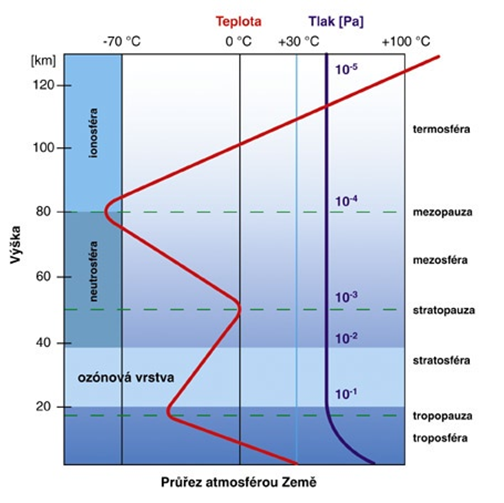
Vertical distribution of the atmosphere according to other properties
Vertical breakdown by physicochemical processes by source4Klima skripta. Gisáci na UPOL: GIS GEOINFORMATIKA A ROMANTIKA [online]. Olomouc: MarijaStudio, 2007 [cit. 2017-09-03]. Dostupné z: http://www.gisaci.upol.cz/filesftp/Klima_skripta.pdf:
Neutrosphere – up to 60-70 km, the concentration of ions is so small that they are not affected by the reflection of radio waves, especially uncharged particles,
Ionosphere – from 60 to 500 km, gases are very conductive due to high concentration of ions, sometimes affects radio communication,
Chemosphere – photochemical reactions of molecules take place here O2 , O3 , N2,
Vertical subdivision according to the nature of kinetic processes:
Exosphere – outer atmosphere, 500 – 700 km, low air density and high kinetic energy, particles can leave the atmosphere (scattering sphere). Around Z there are also 2 radiation belts – radiation belts.
Vertical breakdown by chemical composition:
Homosphere – up to 90 km, does not change the volume fraction of gases in the mixture, the effect of intense turbulent mixing of air, this layer affects the heat balance of the Earth,
Heterosphere – above 90 km, mixing is weak, the gases that are heavier than air naturally decrease; at an altitude of several thousand km atomic hydrogen predominates; photodissociation of gas molecules takes place here and due to absorption of solar energy the temperature in the heterosphere is several hundred °C.
Thermal phenomena in the atmosphere and solar radiation
Heat exchange methods by source5NEČAS, Tomáš. Fyzika v atmosféře aneb základy meteorologie: Modulární systém dalšího vzdělávání pedagogických pracovníků JmK v přírodních vědách a informatice CZ.1.07/1.3.10/02.0024. Brno: Přírodovědecká fakulta, Masarykova univerzita v Brně, 2011. Dostupné z: http://ucitele.sci.muni.cz/materialy/94_1.pdf:
the atmosphere is heated by radiation from the Sun – solar constant about 1360 W/m 2,
the atmosphere is cooled by radiation to the Universe,
the heating of the Earth is uneven – it depends on the angle of incidence of radiation, the time of insolation, the composition of the atmosphere, albedo (reflected radiation),
the flow of water and air distributes heat energy throughout the Earth,
The heat capacity of the water is also of great importance.
Solar radiation (radiation) is electromagnetic (hereafter EM) radiation. It is currently the only source of heat and light, and the only source of energy for the planetary geosystem and the UKS. Other sources are insignificant. The source is H converted to He in thermonuclear reactions in the Sun. It spreads in the form of el. and magnet. waves (3*10 8 m.s -1 ). Wavelength10-14 – 10-2 m.
Corpuscular radiation 6Klima skripta. Gisáci na UPOL: GIS GEOINFORMATIKA A ROMANTIKA [online]. Olomouc: MarijaStudio, 2007 [cit. 2017-09-03]. Dostupné z: http://www.gisaci.upol.cz/filesftp/Klima_skripta.pdf–a stream of electrically charged particles of matter (electrons, protons, neutrons,…), e.g. the solar wind (continuous flow of plasma from the solar corona). The magnitude of the radiation is in W.m -2 . Intensity is in Wh, or kWh. 1 Wh=3,6*10 3 J.
The total amount of solar radiation that falls across the spectrum on the upper boundary of the atmosphere is the so-called solar constant = 1373 +/-20 W.m -2 . The bundle of the sun’s rays is taken to be parallel with respect to the N-Z distance. The amount of direct solar radiation incident on a unit horizontal or inclined surface per unit time is called insolation.
The greatest insolation is on the perpendicular surface. Insolation at the upper boundary of the atmosphere is extraterrestrial insolation. The annual mode of irregular extraterrestrial insolation is the solar climate. The amount of incident radiation depends on the z.s. Spectrum: UV, VIS, IR, MW. 99% is in the 0.1- 4.0 μm. More than 4 μm is longwave radiation. UV is not perceived by the eye, it is less than 0.400 μm, 6.7% before entering the atmosphere, it is absorbed by ozone and almost nothing reaches the surface. VIS – 0.400-0.730 μm, 46.8%, from violet to red. 0.4738 blue-green light has the greatest intensity. IR – 0.730-1000 μm, 46.5%.
Types of radiation – direct solar (insolation), diffuse (diffuse), global (direct + diffuse), reflected (albedo), atmospheric back radiation and Earth radiation (thermal).
Water in the atmosphere
Humidity is one of the basic meteorological elements and expresses the amount of water vapour in the air. Air humidity characteristics can be expressed as both 2D (geographical coordinates) and 3D (geographical coordinates and a selected vertical section). If the humidity increases with altitude it is a humidity inversion.
Characteristics:
Water vapour stress (pressure) – expresses the partial pressure of water vapour mixed with dry air. It is given in hPa (15-20), if the air is saturated it replaces this value by the saturation stress.
Absolute humidity and – the amount of water vapour per unit volume of air. g.m -3.
Maximum absolute humidity A – is the maximum mass of water vapour that the air can contain at a given temperature. If the maximum amount is exceeded, condensation occurs.
Relative humidity r – ratio of the actual water vapour tension to the maximum absolute humidity A (i.e. maximum saturation), r = a/A, given in % of volume.
Saturation supplement – moisture deficit – the difference between the maximum pressure and the actual water vapour tension.
Specific (specific) humidity – the ratio of the weight of water vapour to the total weight of moist air in the same volume. Dimensionless quantity.
Mixture ratio – the ratio of the mass of water vapour to the total mass of moist air, dimensionless.
Dew point – the temperature at which the water vapour in the air could saturate, this can also occur during adiabatic cooling = without water vapour supply. When it falls below the dew point, condensation occurs – dew, fog. Humidity below 100% is always lower than air temperature, it is given in °C.
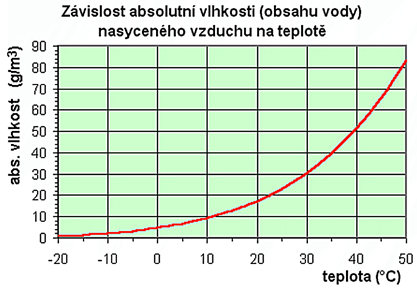
Atmosférický tlak
Air pressure is felt in all places on the Earth’s surface, in all directions equally. The air (atmosphere) has a mass and this mass exerts a pressure on the earth’s surface. Pressure is a force acting at a given point in the atmosphere perpendicular to an arbitrarily oriented surface. The average pressure at sea level and a temperature of 15°C is 1013.27 hPa. Pressure varies with altitude – 1hPa/8 m (according to the source8Klima skripta. Gisáci na UPOL: GIS GEOINFORMATIKA A ROMANTIKA [online]. Olomouc: MarijaStudio, 2007 [cit. 2017-09-03]. Dostupné z: http://www.gisaci.upol.cz/filesftp/Klima_skripta.pdf), see the picture.
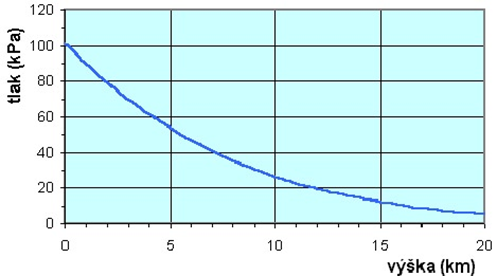
The equation of state for gases [17] – p × v = r × T , where p = pressure, v = specific volume, T = absolute temperature, r = gas constant and depends on the nature of the gas (287 m 2 s -2 K -1 ). The density of air depends directly on its pressure and indirectly on its temperature.
Pressure field – baric field – the horizontal distribution of air pressure is a result of the variability of solar radiation hitting the Earth’s surface and determines the wind regime. The distribution of atmospheric pressure is called the baric field, areas of equal pressure are connected by isobars.
Maps of isobaric topography – show the constantly changing position of isobaric surfaces.
Map of absolute bar topography – we plot the heights of isobaric surfaces above sea level. If we rank only higher isobaric surfaces above lower ones – map of relative bar topography.
Horizontal pressure distribution by source9NEČAS, Tomáš. Fyzika v atmosféře aneb základy meteorologie: Modulární systém dalšího vzdělávání pedagogických pracovníků JmK v přírodních vědách a informatice CZ.1.07/1.3.10/02.0024. Brno: Přírodovědecká fakulta, Masarykova univerzita v Brně, 2011. Dostupné z: http://ucitele.sci.muni.cz/materialy/94_1.pdf:
the pressure is not the same everywhere even after conversion to sea level (87kPa – 109kPa),
there is a pressure gradient, a flow,
pressure high (anticyclone) and pressure low (cyclone), see figure.
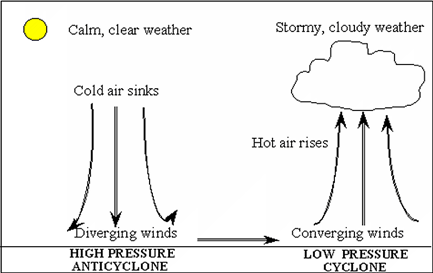
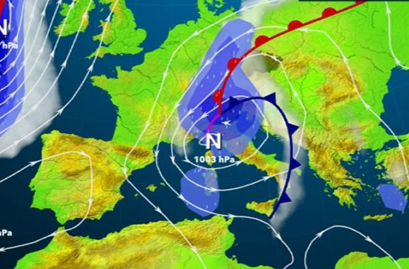
Basic pressure formations by source10Klima skripta. Gisáci na UPOL: GIS GEOINFORMATIKA A ROMANTIKA [online]. Olomouc: MarijaStudio, 2007 [cit. 2017-09-03]. Dostupné z: http://www.gisaci.upol.cz/filesftp/Klima_skripta.pdf: the pressure field consists of areas of high and low air pressure.
Cyclone – TN – closed isobars, in the middle is the lowest pressure.
Anticyclone – TV – closed isobars, in the middle is the highest pressure.
Low pressure gate – V-shaped, the axis is the point with the lowest pressure, between two TVs. High pressure ridge – U-shape, the ridge is the highest pressure.
Baric saddle – a region in the atmosphere, between two TV or TN, neutral poin
Time changes of air pressure – non-periodic character, gradual (max. 20-30 hPa/day).
Daily pressure course – double course – maximum before noon and before midnight, min. Early morning and after noon. Amplitude fluctuates 3-4 hPa. Caused by the diurnal course of active surface temperatures, diurnal atmospheric oscillations and tidal movements of the atmosphere. Max. 1083.3 hPa in Siberia, min. 870.0 hPa eye of typhoon.
The annual course of air pressure – related to the seasonal movement of pressure formations and pressure changes of stationary pressure formations. Mainland type – max winter, min summer. Oceanic – max. early summer, min. winter. Monsoon type – winter max, summer min.
Zonality in air pressure distribution – equatorial NT, subtropical VT, subpolar NT, polar VT. “The regularities of the zonal distribution of air pressure are critical to the nature of the general circulation of the atmosphere”.
Continuation of the article here: Fyzika Atmosféry (2) (kint.cz)
